

Thérèse Oulton. Therese Oulton - Works available from Marlborough Fine Art London, UK. Boyle Family. Boyle Family (About) Claude Monet: Painting Palettes and Techniques of the Masters. There are two common misnomers about Monet.

The first is that, as an Impressionist, Monet's paintings were done spontaneously. In fact, Monet studied his subjects intently, planned his paintings, and worked hard to achieve his results. He often painted a series of the same subject to capture the changing effects of the light, swapping canvases as the day progressed. Impressionism: Art and Modernity. Impressionism. Impressionism. The term, first used derisively, was derived from the title of a painting exhibited in 1874 by Monet, who exhibited the work independently of the official Salon in Paris along with artists such as Renoir, Cézanne and Pissarro. 'Impressionism' subsequently became widely used to describe the type of painting practised by this group of artists who exhibited together eight times up until 1886.
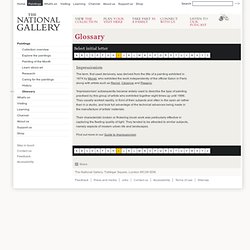
They usually worked rapidly, in front of their subjects and often in the open air rather than in a studio, and took full advantage of the technical advances being made in the manufacture of artists' materials. Their characteristic broken or flickering brush work was particularly effective in capturing the fleeting quality of light. They tended to be attracted to similar subjects, namely aspects of modern urban life and landscapes. Find out more in our Guide to Impressionism. Paintings by Monet, Degas and Renoir. The term 'Impressionist' was first used as an insult in response to an exhibition of new paintings in Paris in 1874.
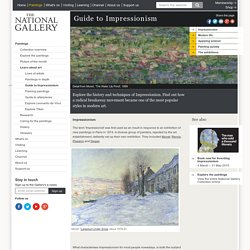
A diverse group of painters, rejected by the art establishment, defiantly set up their own exhibition. They included Monet, Renoir, Pissarro and Degas. What characterises Impressionism for most people nowadays, is both the subject matter and the technique. Landscapes, and scenes from modern urban and suburban life painted in bright, pure colours are typical. Impressionists often began (and sometimes completed) their paintings outdoors rather in a studio. Claude Monet's Cataracts, Monet's Vision. Monet•Biography•Monet's Health From early on, Monet’s health would have an unusual and unexpected influence on his life and art.
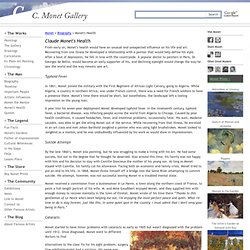
Recovering from one illness he developed a relationship with a painter that would help define his style. After a bout of depression, he fell in love with the countryside. A popular doctor to painters in Paris, Dr. Georges de Bellio, would become an early supporter of his, and declining eyesight would change the way he saw the world and the way viewers saw art. Typhoid Fever. Eye diseases changed great painters' vision of their work later in their lives. ?
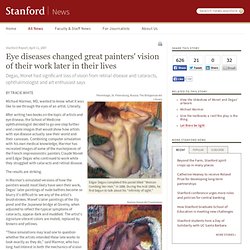
Hermitage, St. Petersburg, Russia/ The Bridgeman Art Library Edgar Degas completed this pastel titled “Woman Combing Her Hair,” in 1886. During the mid-1880s, he first began to talk about his “infirmity of sight.” Norton Simon Art Foundation By the time Degas completed “Woman Drying Her Hair” in 1905, his eyesight had dropped to somewhere between 20/200 and 20/400. Monet's Love Affair with Japanese Art. One day in 1871, legend has it, a French artist named Claude Monet walked into a food shop in Amsterdam, where he had gone to escape the Prussian siege of Paris.
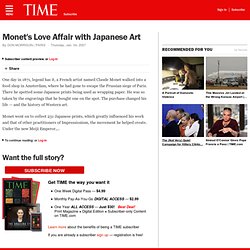
There he spotted some Japanese prints being used as wrapping paper. He was so taken by the engravings that he bought one on the spot. The purchase changed his life — and the history of Western art. Katsushika Hokusai And His Influence On Claude Monet. Monet and Japan. Japanese Bookblock, Claude Monet's collection. A Taste for Japan Who launched the frenzy for all things Japanese, called Japonism, in the 19th century ?
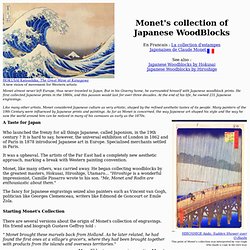
It is hard to say, however, the universal exhibition of London in 1862 and of Paris in 1878 introduced Japanese art in Europe. Specialised merchants settled in Paris. It was a upheaval. The artists of the Far East had a completely new aesthetic approach, marking a break with Western painting convention. Monet, like many others, was carried away. The fancy for Japanese engravings seized also painters such as Vincent van Gogh, politician like Georges Clemenceau, writers like Edmond de Goncourt or Emile Zola. Hokusai's Influence on Monet, Claude Monet Japonisme. Monet•Biography•Artistic Influences•Katsushika Hokusai One of Monet’s interests, in addition to painting and gardening, was collecting Japanese art.
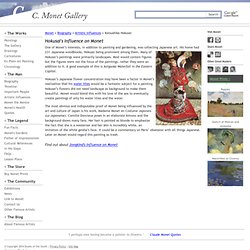
His home had 231 Japanese woodblocks, Hokusai being prominent among them. Many of Hokusai’s paintings were primarily landscapes. Most would contain figures but the figures were not the focus of the paintings, rather they were an addition to it. 'Water-Lilies', Claude Monet. Claude Monet Blue Water Lilies. Bridge over a Pond of Water Lilies. Claude Monet. Water Lilies. 1914-26. Gallery Text:
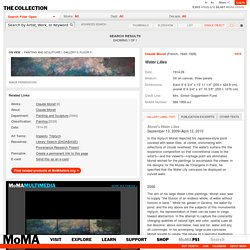
Claude Monet. Claude Monet. The Water-Lily Pond. In 1883 Monet moved from the north-west of Paris to Giverny where he lived until his death.
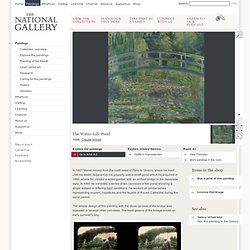
Adjacent to his property was a small pond which he acquired in 1893, where he created a water garden with an arched bridge in the Japanese style. In 1900 he exhibited a series of ten canvases of the pond, showing a single subject in differing light conditions. He worked on similar series representing poplars, haystacks and the façade of Rouen Cathedral during the same period. The simple design of this painting with the close-up view of the bridge was repeated in several other canvases. The fresh greens of the foliage evoke an early summer's day. Water Lilies. Water Lilies (or Nymphéas, pronounced: [nɛ̃.fe.a]) is a series of approximately 250 oil paintings by French Impressionist Claude Monet (1840–1926).
The paintings depict Monet's flower garden at Giverny and were the main focus of Monet's artistic production during the last thirty years of his life. Many of the works were painted while Monet suffered from cataracts.[1] On 19 June 2007, one of Monet's water lily paintings sold for £18.5 million at a Sotheby's auction in London.[10] On 24 June 2008 another of Monet's water lily paintings, Le bassin aux nymphéas, sold for almost £41 million at Christie's in London, almost double the estimate of £18 to £24 million.[11] Gallery[edit] Water-Lily Pond and Weeping Willow, (1916–19)Water Lilies (TFAM), 1908, Tokyo Fuji Art Museum Notes[edit] ^ Jump up to: a b "Monet, Claude. " External links[edit] Claude Monet and Ultraviolet Light. Did the Master Impressionist painter have UV supervision ?
Did the ability to see UV lead Monet to paint with a more blueish palette ? Everybody sees the world around them in different ways and although this is usually down to interpretation, some people can physically see more of the world around them. 'Cataracts the key to Monet's blurry style' As Monet's sight worsened, his works turned from fresh, bright colours to blurred visions of heavy browns and reds, abandoning the floral vision of his famous garden at Giverny, north of Paris.
Dr Marmor looked at scenes and models that Monet painted repeatedly, and found that the changes in colour and detail run parallel to the changes in his sight. Monet underwent two surgeries for his cataracts in 1923, two years before his death aged 85. Although Monet's eyesight problems were not recognised until after he painted Water-Lily Pond, Dr Marmor believes his sight was already deteriorating.
The cataracts severely limited his colour discrimination, which may explain the muddied tone of his later paintings. "He couldn't really judge what he was seeing," said Dr Marmor. Claude Monet. Born in Paris, the son of a grocer, Monet grew up in Le Havre. Contact with Eugène Boudin in about 1856 introduced Monet to painting from nature. He was in Paris in 1859 and three years later he entered the studio of Charles Gleyre, where he met Pierre-Auguste Renoir, Alfred Sisley and Frédéric Bazille.
Claude Monet Biography. Claude Monet was a famous French painter whose work gave a name to the art movement Impressionism, which was concerned with capturing light and natural forms. Synopsis Claude Monet was born on November 14, 1840, in Paris, France. He enrolled in the Academie Suisse.